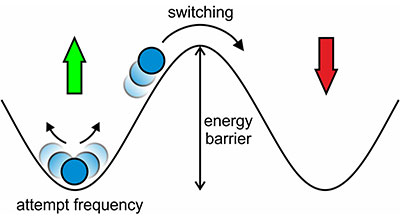Spin Dynamics and Manipulation
Spin dynamics
In a system exhibiting magnetic anisotropy, the magnetization direction of a single-domain particle shows preferential orientations in space, given by the minima of the anisotropy energy. For switching the magnetization direction between different easy axis states, the total anisotropy energy barrier has to be surmounted. For very small magnetic nanostructures, the thermal energy of the particle can be comparable to the energy barrier, resulting in purely thermally activated magnetization reversals.
SP-STM is a suitable tool to investigate spin dynamics phenomena in atomic-scale magnets. Positioning a magnetic tip stationary above a magnetic nanostructure and monitoring the spin-polarized tunnel current, the magnetization reversal behavior of the magnet is observed in real-time.
From the experiments, manifold insight into the physics of spin dynamics is provided:
- the mean time between subsequent switching events yields the intrinsic lifetime of the magnetic states
- the temperature dependence of thermally switching nanomagnets can be investigated using SP-STM at variable temperature
- for magnets exhibiting an Arrhenius-like switching behavior, the effective activation energy barrier as well as the attempt frequency can be determined from a temperature-dependent study
- the role of size and shape can be investigated by comparing the switching behavior of different nanomagnets
- the dynamic coupling between neighboring magnets can be investigated by correlating their thermal switching behavior.
Spin manipulation
SP-STM is a versatile tool for spin manipulation in terms of current-induced magnetization switching of individual atomic-scale nanostructures. Here, spin angular momentum is transfered from a magnetic tip to a nanomagnet via the spin-polarized tunnel current, thereby triggering magnetization reversal. Using a magnetic tip provides a well-defined source of spin-polarized electrons tunneling from the magnetic tip apex into the sample. In combination with the ultimate lateral resolution of SP-STM, a very precise high spin-polarized tunnel current injection is realized. Investigating the injection-site dependent response of a nanomagnet to a high spin-polarized tunnel current, three main contributions to current-induced magnetization switching are separated:
- Joule heating, increasing the effective temperature of a nanomagnet and consequently decreasing the magnetic state lifetime
- Spin-transfer torque, resulting in a very directive magnetization reversal of a nanomagnet
- Oersted field, acting like an inhomogeneous external magnetic field that encircles the tunnel current injection point. Depending on the site of spin-polarized tunnel current injection, the Oersted field may support or hinder the magnetization reversal driven by spin-transfer torque.
 Figure: Basic principle of superparamagnetic switching: Driven by thermal agitation, the effective activation energy barrier is surmounted, resulting in magnetization reversal.
Figure: Basic principle of superparamagnetic switching: Driven by thermal agitation, the effective activation energy barrier is surmounted, resulting in magnetization reversal.
Whereas a high spin-polarized tunnel current modifies the magnetic state lifetimes of thermally switching nanomagnets, SP-STM is also used on quasistable magnetic systems to trigger magnetization reversals. Here, the combined action of Joule heating and spin-transfer torque allows for a heat-assisted spin switching. By steadily increasing the spin-polarized tunnel current, the threshold for reversal can be determined, whereas short tunnel current pulses in the ms regime are used to reliably switch a nanomagnet between its two states.
Animation: Manipulating individual nanomagnets using SP-STM: Whereas the magnetic state is read out at low tunnel current, a high spin-polarized tunnel current triggers magnetization reversal.
